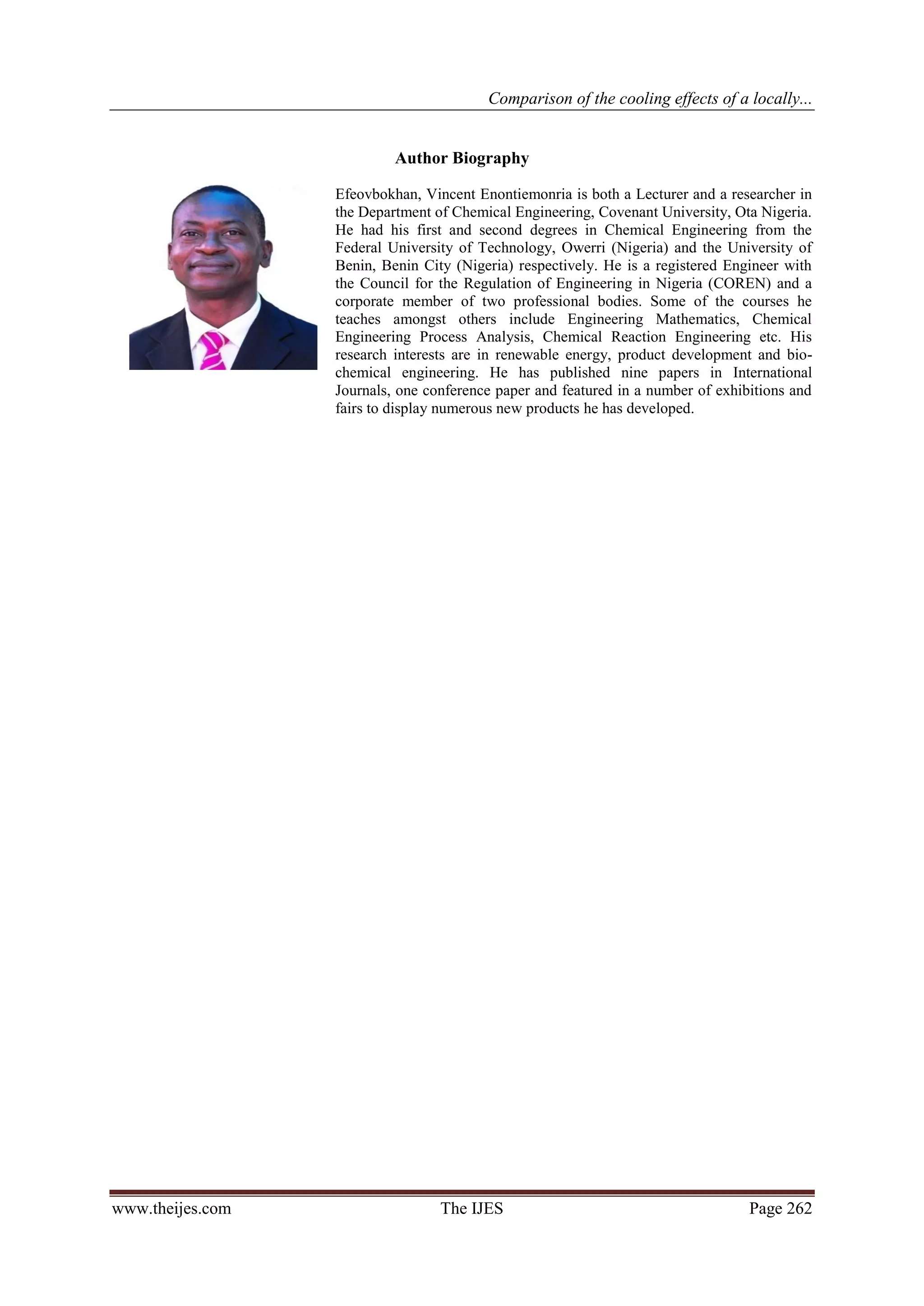This document compares the cooling properties of a locally formulated radiator coolant (Sample C) to water (Sample A) and a commercial coolant (Sample B). Sample C had the highest boiling point at 110°C, followed by Sample B at 101°C, then Sample A (water) at 100°C. This means Sample C can absorb more heat before boiling over. Sample C also had the highest specific heat capacity at 4238 Jkg-1K-1, providing better heat absorption than the other samples. The locally formulated Sample C performed best in raising the boiling point and absorbing heat, indicating it can cool engines more effectively than the other coolants tested.
![The International Journal of Engineering And Science (IJES)
||Volume|| 2 ||Issue|| 01 ||Pages|| 254-262 ||2013||
ISSN: 2319 – 1813 ISBN: 2319 – 1805
Comparison of the cooling effects of a locally formulated car
radiator coolant with water and a commercial coolant
1
Efeovbokhan, Vincent Enontiemonria, 2Ohiozua, Ohireme Nathaniel
1, 2
Department of Chemical Engineering, Covenant University, Canaan Land, Ota, Nigeria
-----------------------------------------------------------Abstract------------------------------------------------------
The cooling properties of a locally formulated coolant (sample C) vis-a-vis, its boiling characteristics and
specific heat capacity were investigated along side with a common coolant-water (as sample A) and a
commercial coolant (sample B). The results of the investigation showed that sample C gave the best
performance compared to the other two samples A and B: the boiling points of sample C was 1100C, sample A
1000C, and sample B 1010C. This means that the possibility of a boil-out of sample C from the radiator is little
compared to samples A and B. Also, for the same quantity of coolant more heat would be required to raise
sample C to its boiling point than for samples A and B. In other word, better cooling would be achieved using
sample C. The specific heat capacity for sample C was 4238 Jkg -1K-1, which was also a good compromise
against samples Abut better than sample B having 4266 Jkg-1K-1 and 4208Jkg-1K-1 respectively.
Key Words: Radiator coolants, Corrosion inhibitors, Overheating, Engines.
----------------------------------------------------------------------------------------------------------------------------------------
Date of Submission: 31th December, 2012 Date of Publication: Date 20th January 2013
----------------------------------------------------------------------------------------------------------------------------- -----------
I. Introduction:
A coolant is a fluid which flows through a device in order to prevent its overheating, transferring the
heat produced by the device to other devices that utilize or dissipate it. An ideal coolant has high thermal
capacity, low viscosity, is low-cost, and is chemically inert, neither causing nor promoting corrosion of the
cooling system.[1-3]. It is usually compounded with a high boiling point liquid which also serves as an anti-
freeze agent against extremely cold conditions and problem of overheating in hot weather. A higher boiling
temperature means that the coolant can cool better as your engine gets hotter. It also reduces the chance of
blowing a head gasket. About a third of the heat energy produced by an internal combustion engines ends up as
waste heat in the cooling system [4]. Radiator coolant raises the boiling point of the water, allowing it to carry
more heat away from the engine, and thereby preventing engine damage due to overheating. The coolant
extracts and disperses more heat fast from the engine and also responds fast to cooling in the radiator for another
cycle. That fluid referred to as coolant or antifreeze or anti-boil removes heat around and through the engine to
radiator which helps to moderate the engines temperature. [5]. Coolants when circulated throughout the engine it
improve heat resistant property, maintain optimal internal operating temperature and deter scales in the engine
cooling system that clogs the radiator fins. [6]. The cooling system of the car engine is very important because
improper care of the cooling system leads to an engine failure. Aside from optimal engine performance,
maintaining the coolant level will go a long way towards prolonging the life of the radiator and other
components in the cooling system. Decrease in the cooling system’s ability to absorb, transport and dissipate
heat caused by low coolant level, loss of coolant (through internal or external leaks), poor heat conductivity
inside the engine because of accumulated deposits in the water jackets are some of the major causes of
overheating [7]. If the coolant in an engine cooling system is changed before corrosion inhibitors reach
dangerously low levels, corrosion damage is prevented [8]. Therefore it is important to use a coolant to avoid
possible engine failure, a car coolant or antifreeze is used in internal combustion engines, and for many other
heat transfer applications. Compounds are added to the water to both raise the boiling point and reduce the
freezing point temperature of the mixture. Corrosion inhibitors may also be added at this stage if desired. The
term Colligative agent may better describe the benefits of these compounds in warm climates, since they not
only achieve freezing point depression in an extremely cold weather when mixed with water; they coincidentally
achieve boiling point elevation of water. Inhibitors are chemicals that react with a metallic surface, or the
environment involved, this surface is exposed to, giving the surface a certain level of protection. Inhibitors
often work by adsorbing themselves on the metallic surface, protecting the metallic surface by forming a film.
Inhibitors are normally distributed from a solution or dispersion. Some are included in a protective coating
formulation. Inhibitors slow corrosion processes by either: Increasing the anodic or Cathodic polarization
www.theijes.com The IJES Page 254](https://image.slidesharecdn.com/ap02102540262-130306224806-phpapp01/75/The-International-Journal-of-Engineering-and-Science-The-IJES-1-2048.jpg)
![Comparison of the cooling effects of a locally...
behaviour, reducing the movement or diffusion of ions to the metallic surface and increasing the electrical
resistance of the metallic surface. [9] Colligative agents are properly referred to as both antifreeze and "anti-
boil" when used for both properties. The term engine coolant is widely used in the automotive industry, which
covers its primary function of heat transfer. Coolants, when circulated throughout the engine improve heat
resistant property of additives, maintain optimal internal operating temperature and deter scales in the engine
cooling system that clogs the radiator fins. [10]. Over heating results when coolants are not used. Overheating
could result in accelerated deterioration of the oil and subsequently the engine itself. [11]. Basically in this
research, coolant has become a remedy for the problem of overheating and freezing of a cooling system.
Coolants are formulated to have the right mix of water and antifreeze to provide adequate freezing and boiling
protection. The commonest antifreeze used is ethylene glycol and has a freezing point of 8.6°F (-13°C) and a
boiling point of 388°F (198°C), and is completely miscible with water. Ethylene glycol could just as well be
called "anti-boil." In industries, ethylene glycol is used as a solvent [12-16].
II. Materials And Methods
Three different coolants including water (Sample A), a coolant purchased from auto car care products,
Ota (Sample B), and the formulated coolant (Sample C), were considered. Sample C consists essentially of a
50/50 blend of ethylene glycol and water, 1% corrosion inhibitor and a Dye (green) added to taste were all
mixed in their correct proportions.
2.1 Determination of Boiling Point of Coolant
A simple and widely used method for determining the identity of a car radiator coolant is by measuring
the temperature at which it boils. This temperature, called the boiling point, is a physical property. Boiling point
is formally defined as the temperature at which the vapour pressure of the liquid becomes equal to the pressure
at the surface of the liquid. The boiling point of a liquid can change if the pressure at the liquid's surface changes
2.1.1 Procedure
150 ml coolant in a 250ml beaker was set on wire gauze over a Bunsen burner and a thermometer
placed in the coolant so that it does not touch the beaker. The thermometer must not be used as a stirring rod.
The coolant was heated with continuous stirring, measuring and taking temperature readings every one minute
until the coolant began to boil. The temperature at which the coolant began to boil was then noted. The
experiment was terminated when the temperature remained constant at this boiling point for five consecutive
readings.
2.2 Determination of the Specific Heat Capacity of Coolant by Method of Electrical Heating [17].
Specific heat capacity is the amount of energy needed to increase the temperature of one gram of a
substance by one degree Centigrade. The property of specific heat (kcal/kg c) describes the amount of heat
required to raise a certain mass through a certain temperature change.
2.2.1 Procedure:
The joule calorimeter and its stirrer without the jacket and heating coil were first weighed. The
calorimeter is then filled with the coolant to about 2/3 of its volume. The calorimeter was placed in the jacket
and a heating coil connected to a rheostat was immersed in the coolant such that when the circuit was closed, a
current of 1.5-2.0A was produced in the circuit. As the circuit was closed the stop watch was started at the same
time. The temperature of the coolant at one minute interval was recorded, while stirring the coolant gently and
keeping the current constant by means of the rheostat. The circuit was opened to cut off the current after the
temperature has risen by about 5oC but without stopping the watch, recording of the temperature was continued
at one minute interval until the temperature has fallen by about 2oC below the highest recorded temperature.
Both the steady current and potential difference maintained during the experiment were also recorded.
2.2.2 Calculating the Specific Heat Capacities of Coolants:
The heating and cooling curve for each coolant is first plotted on three different graphs to enable the
computation of the areas A1 and A2 under each graph. The specific heat capacity (c) of the coolants may then
be calculated using the formula:
................ (1)
Or from equation1
.................................... (2)
Where
www.theijes.com The IJES Page 255](https://image.slidesharecdn.com/ap02102540262-130306224806-phpapp01/75/The-International-Journal-of-Engineering-and-Science-The-IJES-2-2048.jpg)

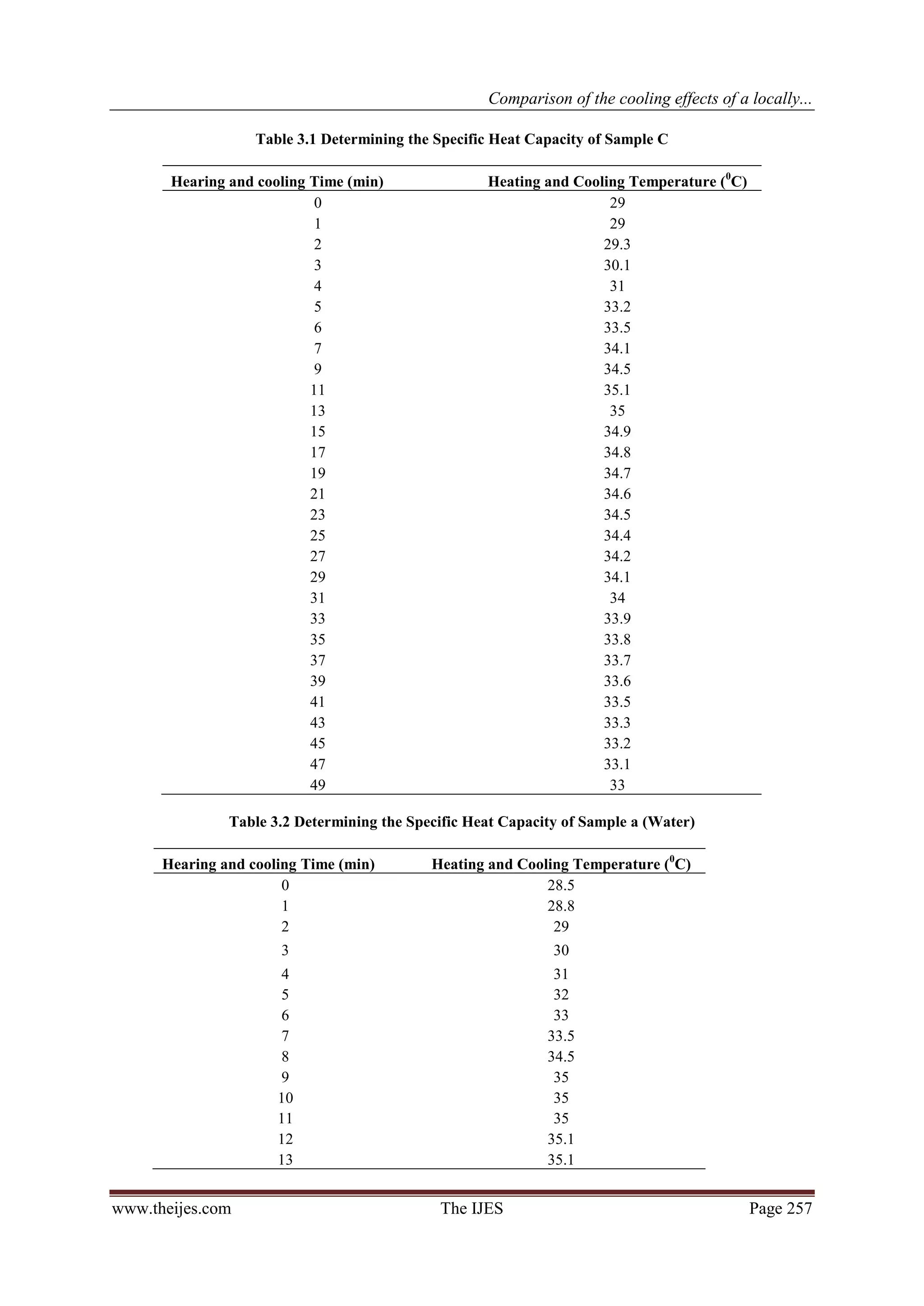
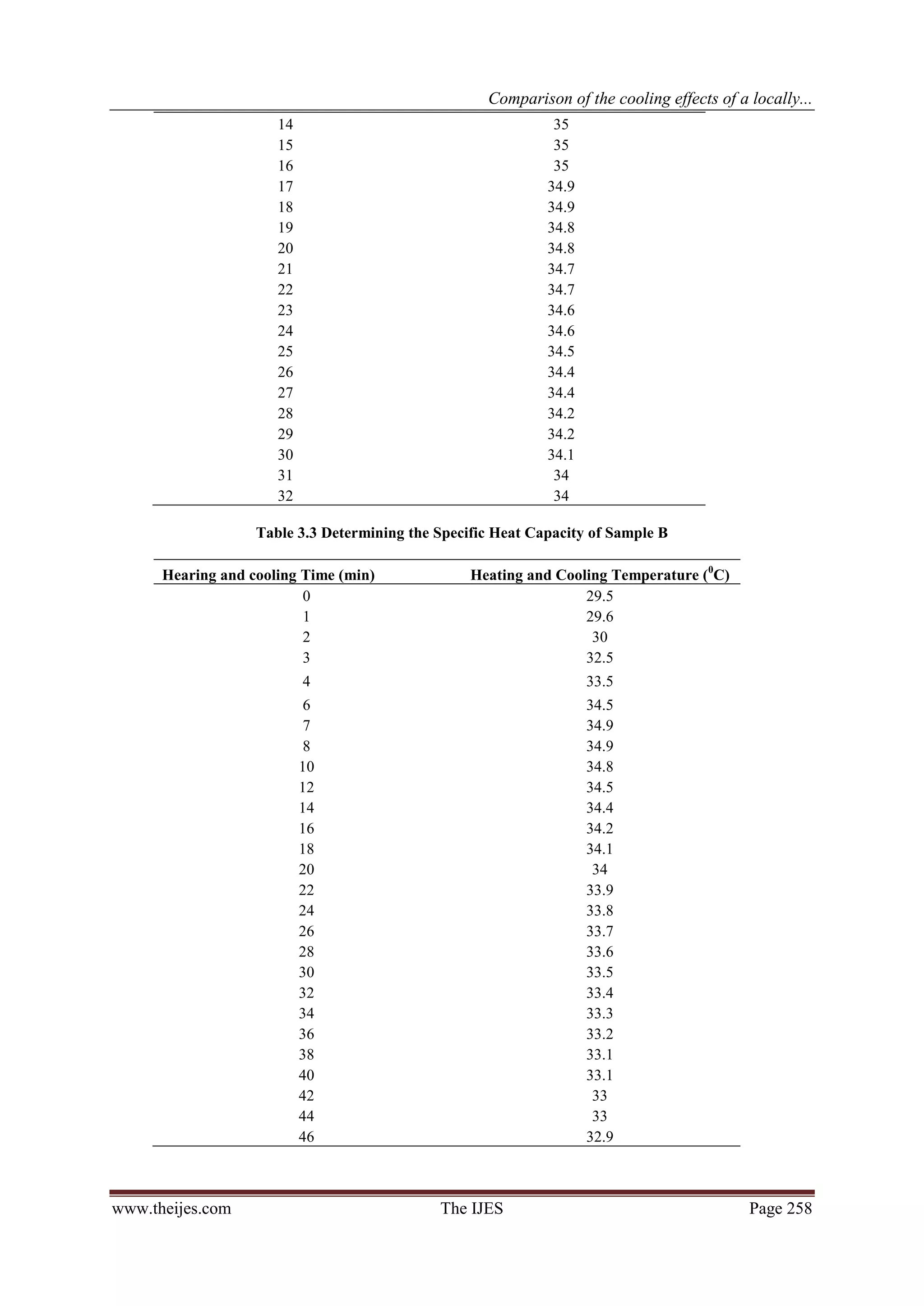
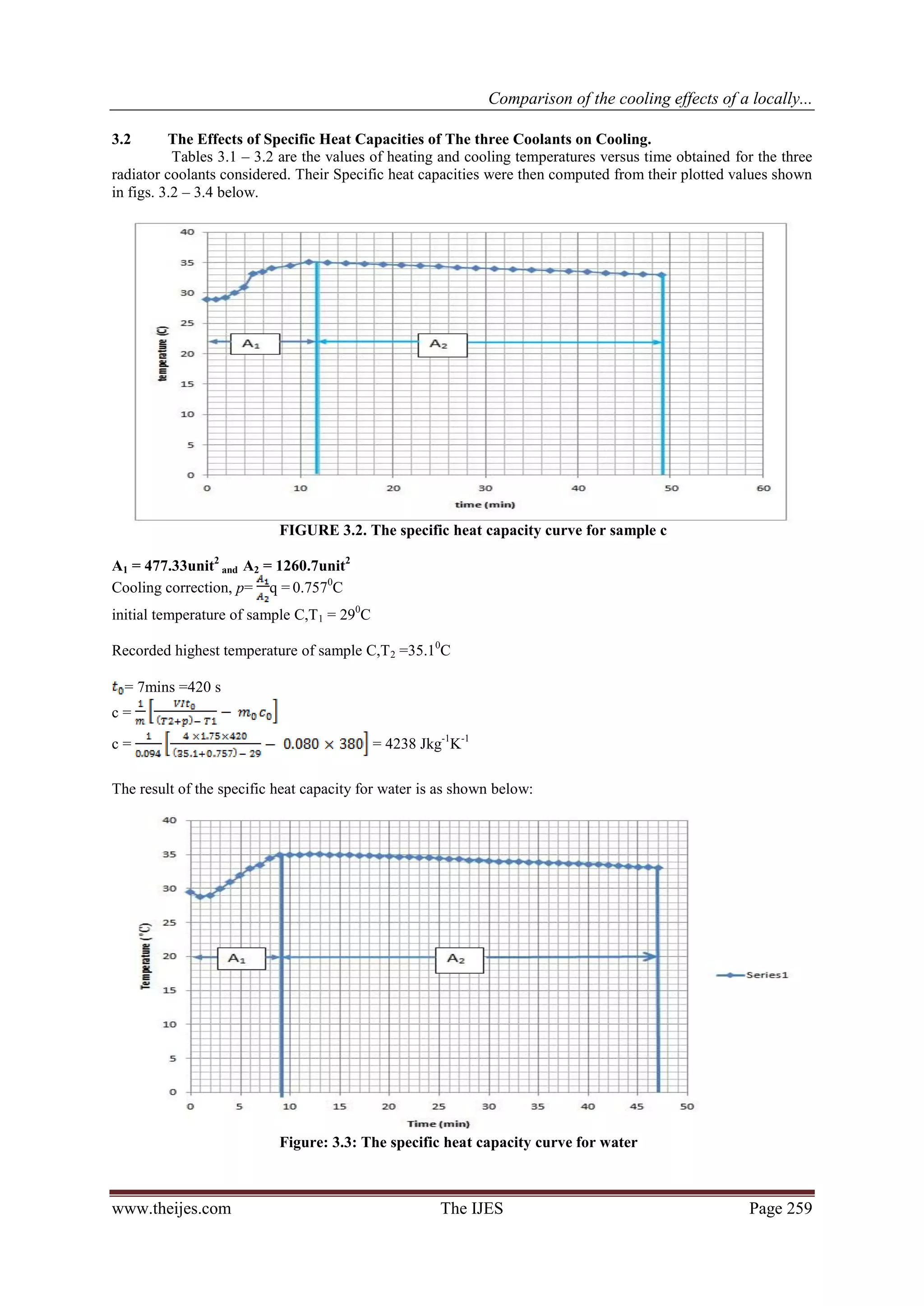
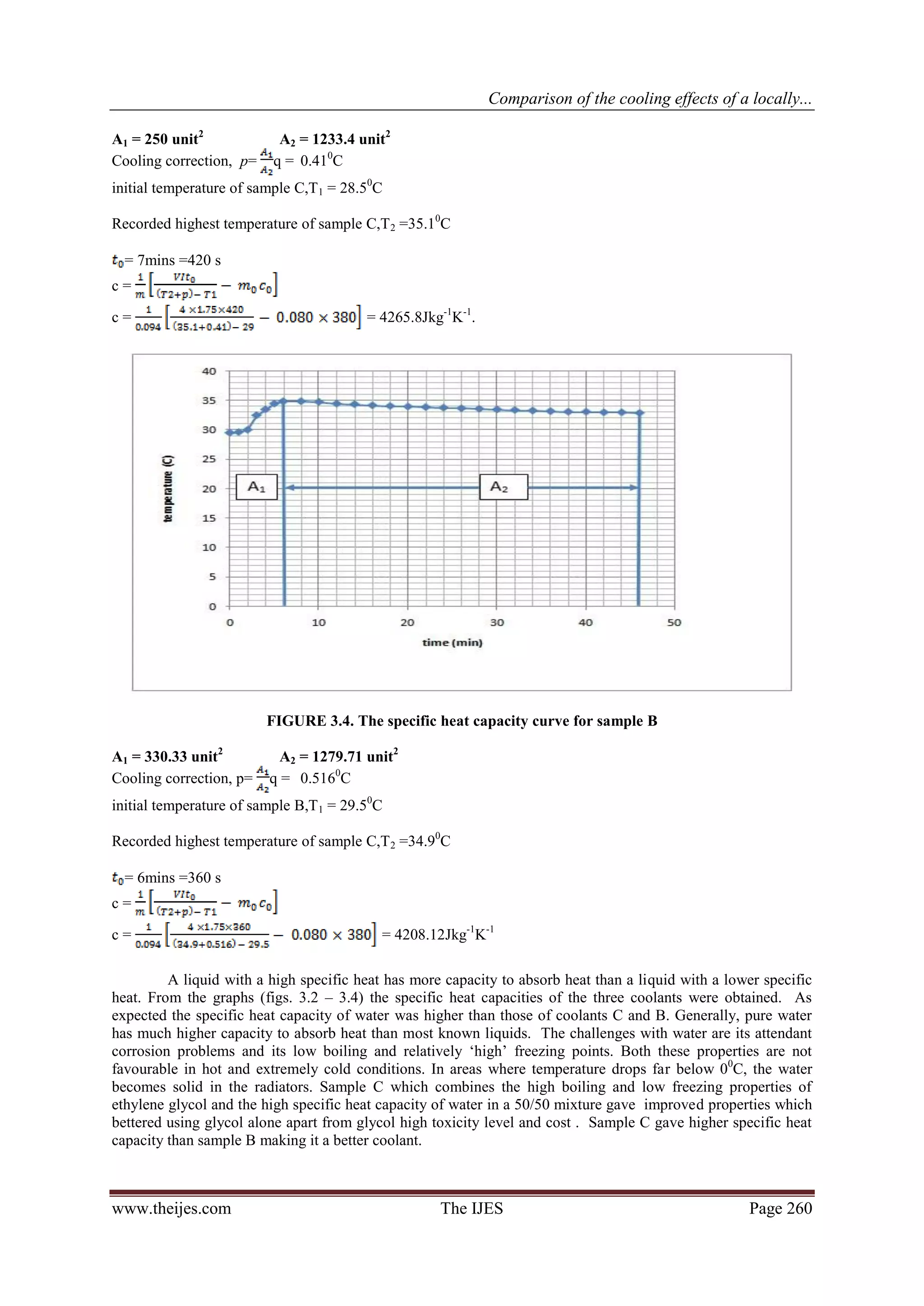
![Comparison of the cooling effects of a locally...
4. CONCLUSION:
The boiling point of the formulated radiator coolant (sample C) was found to be 110 oC, higher than the
other two coolants (Samples A and B).
Sample C would require more heat relative to samples A and B, to raise a unit mass of the coolant to its
boiling point.
Better extraction of heat by sample C results in better cooling effect on car engines.
The use of a high boiling point solvent (mono-ethylene glycol) at the right proportion helps to raise the
boiling point of water by as much as 10 degrees.
The specific heat capacity of Sample C gave 4238 Jkg-1K-1, as against that of water which gave
4265.8Jkg-1K-1.
A blend of 50/50 mix of water and ethylene glycol in which corrosion inhibitors have
been incorporated is much more effective than using water and ethylene glycol alone. While water
alone is good coolant but the enormous corrosion problems associated with it, is enough to discourage its use.
References:
[1]. Antifreeze
http://en.wikipedia.org/wiki/Antifreeze
[2]. Why Change Your own Antifreeze
http://www.peakauto.com/10ez_steps.shtml
[3]. Coolant
http://en.wikipedia.org/wiki/Coolant
[4]. Larry Carley, ( 2002) Arrowhead Radiator Service, Coolant & Radiator Service
http://www.arrowheadradiator.com/coolant_&_radiator_service.htm
[5]. Cicely Enright, (2011) Engine Coolant Standards Adopted. British Standard Reference D15 Standards.
Pg 35
[6] Cummins Filtration (2006)
www.fleetguard.com
[7]. Larry Carley, Underhood Service, (1999) Arrowhead Sevices, Overheating Causes and Cures
http://www.arrowheadradiator.com/overheating_causes_and_cures.htm
[8]. James B. Wills, jr. Agricultural and Biosystems Engineering. Agricultural extension service. University
of Tennessee.
[9]. NACE Resource Centre, Corrosion Inhibitors
http://events.nace.org/library/corrosion/inhibitors/Introduction.asp.
[10]. Cummins Filtration (2006) Cooling syatem
http://www.cumminsfiltration.com/html/en/products/cooling/cooling_system.html
[11]. Kouji Iijima, Satoshi Ohkawa Keisaku Iwakata.(2002 ) Development of Non-Amine Type Engine
Coolant. Komat’s Technical Report vol 48 No 149 Pg 3
[12]. Ethylene Glycol Net Industry science.jrank.org/pages/2587/Ethylene-Glycol.html
[13]. Allan Browning, David Berry (2010) "Selecting and maintaining glycol based heat transfer fluids,"
Facilities Engineering Journal, pages 16-18
[14]. Coolant
http://www.radiator.com/article-radiator-coolant
[15]. How an Engine Cooling System Works
http://www.2carpros.com/articles/how-an-engine-cooling-system-works
[16]. Antifreeze
http://en.wikipedia.org/wiki/Antifreeze
[17]. A.I.IEETE, An Introductory Practical Physics Manual for Universities, Department of physics,
University of Ibadan. (p63 – 64).
www.theijes.com The IJES Page 261](https://image.slidesharecdn.com/ap02102540262-130306224806-phpapp01/75/The-International-Journal-of-Engineering-and-Science-The-IJES-8-2048.jpg)
